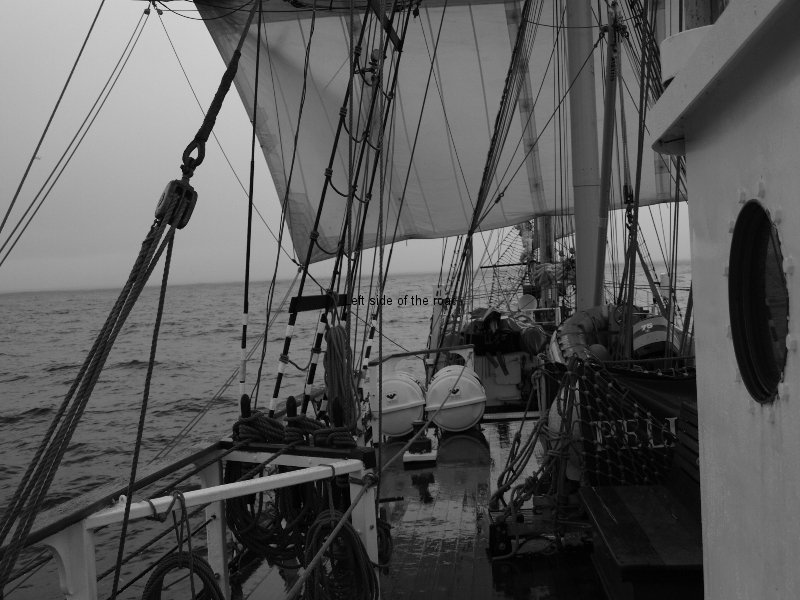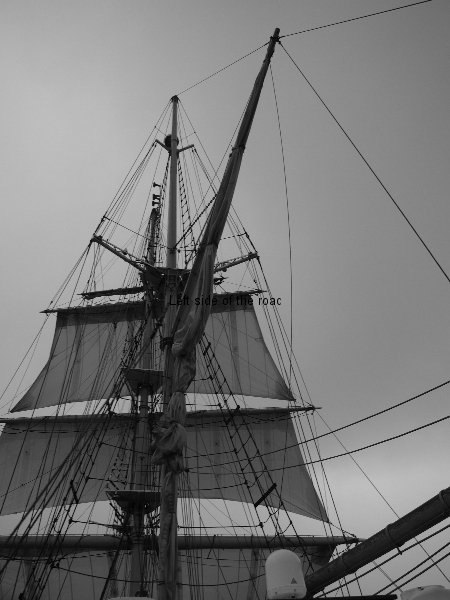More on sailing on a tall ship
The rain in the Caribbean/Western Atlantic might be warm when it falls but you get wet and add a little bit of wind and it’s as unpleasant as being on the top of any mountain in Britain in bad weather.
Getting up for 06.00 is no fun. Doing so when you’ve heard rain against the side of the ship doesn’t make it easier. Being told by the person waking you up that it’s been raining makes it worse. Your cabin mate saying that you’ve 3 hours out in the rain makes it perfect.
But it isn’t raining! That joy is short-lived as you are told there’s ‘a lot of rain on the radar’ and that ‘volunteers’ are needed to go to the top of the mast to untie the uppermost sails, when daylight comes. After wanting the sun to rise you start to hope it never does.
But someone has to do it, and there are few other’s around. Get to the top as soon as possible, do the job and get down quick. We might beat the rain.
We don’t. Half way up the lower shroud it starts. Big drops of the tropical kind. You’re soaked by the time you reach the first top (the nautical name for the platforms at stages up the mast, where each yard (which holds the sails) meets the mast).
Strangely, although the ship is rolling (though in a gentle sea), the rain is now falling heavily, hand and footholds are slippery and wet, there’s no problem with the height. You’re too concerned with the task in hand. That’s the same when out on the yard to untie the sails that have been stowed for the night. The ropes are wet and have swelled – so not that easy to loosen. Only when taking a breather do you notice that the deck is a long way below.
Getting up is ‘easy’. Getting down less so. You are wetter and so is everything you touch. Caution kicks in and progress is slow, too slow. Will have to work on that. Once down of wet (dry) land (or the nearest to it that a deck can be) ropes have to be pulled. By now you’re so wet you don’t give a damn. Then it’s all worth it as the sail fills and speed increases. As you go to change at least you know that it was a job well done.
We have the luxury of heat to dry clothes, the engine room or the tumbler dryer. You have to feel for the sailors in times past who had none of this and were forced out in much worse conditions. I’m complaining and the air temperature this morning, at 07.00, was 23 degrees C.
The dry clothes don’t stay dry for long. Water always finds its way through the best of waterproofs, especially the ones for the countryside and not at their best. Wave upon wave of rain comes, taking us by surprise as it comes from behind and catches us unawares. A chill starts to develop. There’s really no such thing as warm rain, especially on a ship at sea.
Then we are given a pleasant surprise. The wind has dropped and the t’gallant which we untied just over an hour before, has to come down – together with all the others. All that for an hour and about 3 or so miles progress. But this has it up side. All the activity warms you up and moves the watch forward to its conclusion.
Now the ship is coming to life, the day crew starting to appear, they are warm and dry and if out in the rain only for the duration of the task. The sun breaks through, for a few minutes. It’s still hot if it can break through the cloud.
Then the three hours are up. More wet clothes in the dryer. Now a whole 6 hours (or more likely 5½) to relax – before the same again
Only 105 watches or 315 hours on watch (more or less) – depending on the system decided for the next part of the voyage – to go before landing in the UK, with the Atlantic in winter in between.





